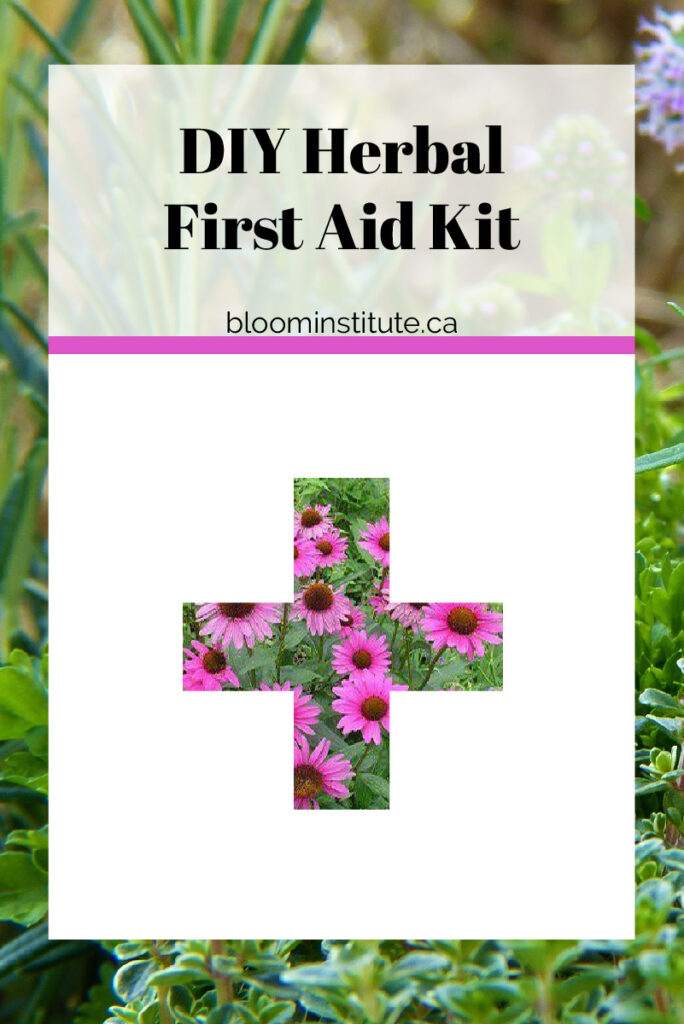I took Holistic Herbal Wellness with Savayda in 2014, and one of the most useful things we learned was how to assemble a herbal first aid kit. Because we learned how to make tinctures and infused oils in the course, I knew how to make some of these items myself after the class, and there are also some items on the list that are worth buying. They’re easy to find at most natural health stores.
 Minor injuries like cuts, bites, burns, bruises and sore muscles can happen to anyone at any time, so it’s a good idea to start assembling these items to cover all the bases.
Minor injuries like cuts, bites, burns, bruises and sore muscles can happen to anyone at any time, so it’s a good idea to start assembling these items to cover all the bases.
Start collecting these herbal remedies now so you’ll be prepared for any minor injuries or discomforts.
Rescue Remedy
A commercially available blend of Bach Flower Essences, available in dropper, spray, or lozenges. For shock, emotional and physical, and stressful situations like dentist visits. Take 4 drops immediately, followed by regular dosing until the situation has stabilized. It can be rubbed onto a person who is injured or in shock and can’t take medicines orally, and can be used topically on pets and with house plants.
Arnica cream Arnica montana
An arnica cream or gel is good to have on hand for bruises, sprains, recovery from operations, dental work etc. It can also be used after mental strain and heart strain. Can help with back pain. Take 2 tablets every two hours for shock or injury, and even after surgery.
You can find Arnica products that are either homeopathic or that contain extracts. I like the Weleda Arnica cream because it has a high percentage of wild-crafted Arnica, but many people also get great results with a homeopathic cream. Traumeel is a popular homeopathic brand.
Tea tree oil Melaleuca alternifolia
Antiseptic, anti-bacterial, anti-fungal. Use on cuts or sores, directly or diluted in a carrier oil. Also use as a mouth rinse or gargle, douche, sitz bath. Wipe for preventing and soothing bug bites.
Ginger capsules or tincture Zingiber officinale
Use for nausea or motion sickness, stomach flu and morning sickness. 1-2 caps or 20 drops tincture before traveling. Valuable for cramps of any kind and indigestion. Combine with other remedies for fever, colds and flu.
The tincture is easy to make with the folk method. Fill a jar ¼ full of fresh ginger, fill the jar with vodka or brandy. Steep for 2 weeks. Strain out the ginger pieces. Put your tincture in a dropper bottle and keep some in the car in case of motion sickness.
Echinacea tincture Echinacea angustifolia, E. purpurea
Use at first sign of cold or infection by taking 30 drops, undiluted, on the back of the throat, every hour, until symptoms subside, up to ten times a day.
Can be used topically for inflammation of the skin, skin infections, bites, stings, cuts, and infections. Dilute 60 drops tincture in ¼ cup of water and use as a wash or compress.
Ear oil Verbascum, Hypericum perforatum, Allium sativum
Infused oil of mullein, St.John’s wort, and garlic. Infuse the oils separately so you can use them for other purposes, and then combine as needed for earache. For earache warm the oil in a double boiler and use 3-5 drops in each ear. Lie on one side and rub the area outside of the ear. It may be helpful to apply heat outside the ear.
Shepherd’s Purse tincture Capsella bursa-pastoris
For minor bleeding, that is non-life threatening such as nose bleeds, minor cuts, bleeding gums. Apply the infusion as a compress. ½ cup of the tea, or 60 drops of tincture can be taken, up to 6 times daily.
Topically: To use as a wash, dilute 30 drops of tincture in ½ cup water
Internally: Take 30 drops every hour until bleeding stops. A cup of the tea is also helpful.
Honey
For burns cover area immediately and leave on until pain subsides (approx. 30 minutes)
Fresh Plantain Plantago major
It’s hard to keep this one in a herbal first aid kit because it is really best used fresh as a poultice. So instead of your herbal first aid kit, keep it in your herbal first aid garden or just leave it growing in your lawn so you’ll always have some on hand. Use it on bug bites, bee stings, burns and cuts and scrapes. To make a poultice, chew a few fresh leaves into a pulp, place this moist leaf pulp directly on the injured/bitten area and wrap in gauze. Keep on the skin for a few hours, re-applying as needed.
Lavender Essential Oil Lavandula angustifolia
A versatile addition to any herbal first aid kit, lavender essential oil can be used topically to help many ailments, including burns, cuts, bruises, sunburns, itchy skin, and cold sores. It also does double-duty because of its aromatherapeutic effects. Lavender is renowned for its ability to relieve stress and anxiety, and promote relaxation. Since you may be a little stressed or irritated if you have an issue that requires a first aid kit, it’s nice to include lavender to soothe your mind.
If you’d like to learn how to forage wild medicinals, infuse oils, and make tinctures, you’ll love Savayda’s 1-year Holistic Herbal Wellness course.
PIN IT:

